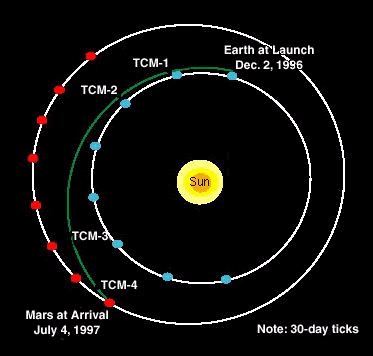

In this graphic you can see the Mars Pathfinder trajectory from its
beginning on Earth, on December 2, 1996, to its goal in Mars, on July 4,
1997.
Note how the Earth (blue dot) overtakes Mars (red dot) during this 7-month
period, both moving in a counter-clockwise direction, in this diagram.
A total of four TCMs are planned for Mars Pathfinder. The first two of these were scheduled in the first two months of the mission while the spacecraft was still relatively close to Earth. The final two TCMs were scheduled near the end of the cruise phase when the spacecraft is close to Mars. Contingency plans allow for a fifth maneuver to be executed just a few hours before atmospheric entry, if necessary.
The second planetary protection requirement imposed on Mars Pathfinder is that the probability of Pathfinder itself impacting Mars at a speed greater than 1,000 ft/sec (1,100 Km/h) be less than 0.001 (or 1/1,000). This requirement is met by designing TCMs 1 and 2 to a target state that is also biased away from the final desired arrival conditions - again, just enough to meet the requirement. The target state is chosen so that if control of the spacecraft is lost following either TCM 1 or 2, the spacecraft will enter the Martian atmosphere with a shallow entry angle, allowing the atmosphere to slow it to below 1,000 ft/sec at impact (assuming the parachute does not deploy).
TCM 1 is designed to move from the biased launch injection target state to the (still) biased Mars arrival state. The change required to move between these two targets is known, so that the nominal size of TCM 1 can be computed exactly. This type of maneuver is called "deterministic". However, there are several types of uncertainties associated with the design and implementation of maneuvers in flight. A second maneuver - TCM 2 - is planned to follow TCM 1 to correct any errors that occur in the design and/or execution of TCM 1. If we knew the spacecraft trajectory exactly and the propulsion system could execute the maneuver perfectly, there would be no need for TCM 2. This type of maneuver is called "statistical" since its characteristics can only be predicted by statistical analyses of the various error sources.
TCM 1 was successfully executed on January 9, 1997.
TCM 2 was successfully performed on February 3, 1997.
TCM 3 was performed on May 7, 1997.
Unfortunately, luck was not with us and the small execution errors
accumulated while performing the maneuver have conspired to place the
spacecraft on a trajectory that is just outside our desired entry
conditions - if uncorrected during TCM 4.
TCM 4 was successfully performed on June 25, 1997.
TCM 5:
A fifth maneuver may be performed just before Pathfinder hits the upper
atmosphere of Mars at 10 A.M. PDT (5 P.M. UTC) on July 4. If it were needed
to fine-tune the spacecraft's 14.2-degree entry angle, it would be
performed either 12 hours or six hours before Pathfinder hits the upper
atmosphere. The Flight Team will decide whether to follow through with that
maneuver the evening before landing.
Updated: July 1 '97
Best seen with MS Internet Explorer.
Back to the Mars Pathfinder Page in ARVAL
Messages: